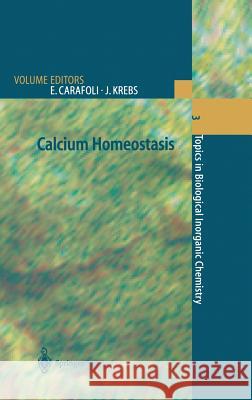Calcium Homeostasis » książka
Calcium Homeostasis
ISBN-13: 9783540671756 / Angielski / Twarda / 2000 / 188 str.
calcium exchanger, which is the topic of the final chapter of the book by N. Gabellini, A. Zatti, and E. Carafoli. Padova Zurich, Ernesto Carafoli February 2000 Joachim Krebs "Yes, calcium, that is everything . . . " Contents Calcium Homeostasis and Its Evolution Robert J. P. Williams . . . . . . . . . . . . . . . . . . . . . . . . . . . . . . . . . . . . . . . . Evolution of EF-Hand Proteins Susumu Nakayama, Hiroshi Kawasaki and Robert Kretsinger. . . . . . . . . . . 29 . Calmodulin Target Recognition: Common Mechanism and Structural Diversity Tao Yuan, Kyoko L. Yap and Mitsuhiko Ikura . . . . . . . . . . . . . . . . 59 . . . . . . Calcium-Binding EGF-like Domains A. K. Downing, P. A. Handford and J. D. Campbell. . . . . . . . . . . . . . 83 . . . . . . . Calmodulin-Dependent Protein Kinases Joachim Krebs. . . . . . . . . . . . . . . . . . . . . . . . . . . . . . 101 . . . . . . . . . . . . . . . Structure of Calcineurin and Its Complex with Immunophilins Claude B. Klee . . . . . . . . . . . . . . . . . . . . . . . . . . . 125 . . . . . . . . . . . . . . . . . 2 The Ca + Pump of Sarcoplasmic and Endoplasmic Reticulum Membranes Giuseppe Inesi and Chikashi Toyoshima. . . . . . . . . . . . . . . . . . . 143 . . . . . . . . 2 The Plasma Membrane Ca + ATPase Danilo Guerini . . . . . . . . . . . . . . . . . . . . . . . . . . . 155 . . . . . . . . . . . . . . . . . 2 The Na+/Ca+ Exchanger: Structural Aspects, Function and Regulation Nadia Gabellini, Alessandra Zatti and Ernesto Carafoli . . . . . . . . . . . . . 173 . . . Calcium Homeostasis and Its Evolution Robert J. P. Williams Inorganic Chemistry Laboratory, University of Oxford, South Parks Road, Oxford, OXl 3QR, UK E-mail: Susie. Compton@chem. ox. ac. uk The homeostasis of calcium is managed very differently in different organisms. A general outline of homeostasis, a dynamic balanced flow, is therefore described before a description of the systems in particular classes of organism. The organisms are treated in the sequence: prokaryotes, single-cell eukaryotes and, lastly, multicellular organisms reaching up to man.











